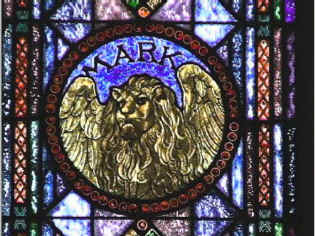Obviously I don’t know what the author had in mind when he wrote about the cursing of the fig tree, but it’s interesting to think about the possibilities.
It is easy, even necessary, for readers to interpret Jesus’ cursing of the fig tree as a symbolic act. Unless we do, we are left with a narrative that depicts Jesus acting petulantly, irrationally, bizarrely. The narrative says he cursed the tree because it had no figs on it — even though it was not the season for figs (Mark 11:12-14).
But even after we do interpret this act as a symbolic gesture pointing to the destruction of Jerusalem, along with its temple and people, we are still left with the gospel narrative that treats the curse as a literal event in the life of Jesus and the apostles. A symbolic reader interpretation cannot erase that fact. And that fact is, on the face of it, nonsensical. The outrageousness of the act is then underscored by Jesus instructing his disciples, and by the narrator instructing his readers, that mere faith is enough to remove a mountain and toss it into the sea. Again, metaphor notwithstanding, the saying is calculated to astonish disciples in both the story and reading audience alike.
Starting from here and working our way back through the gospel it is worth noting that the fig tree curse is the last in a chain of miracles that defy the sense and order of nature.
The wilderness miracles
The gospel opens with John the Baptist struggling to survive in the wilderness on locusts and wild honey (Mark 1:6). The wilderness, we are reminded, by its nature is a place where people normally die for lack of food. Survival is possible only by resorting to extremities to find food. Jesus does not have this problem, nor is he troubled by the dangers of wild animals in the wilderness, since he is cared for (including, presumably, being fed by) angels the whole time. (In the Gospel of Mark Jesus does not even fast in the wilderness. Angels see that he has no need for that — Mark 1:13.)
Food (in particular grain and bread) is found in and around settled areas (Mark 1:31; 2:15-16; 5:43; 6:8-10; 6:36; 7:2, 27; . . .). But the kingdom of God is like new wine that breaks old wineskins. Sometimes the fruits of Jesus’ preaching are so great that he and his disciples are unable to eat even in these places (Mark 3:19-20; 6:31). Contrary to nature and common sense, on one famous occasion when they had been unable to eat, they went into the wilderness (6:31). And we know the miraculous outcome — baskets and baskets of leftovers. But what was the point of this miracle? The disciples — and surely most readers — are not told. The narrator says the disciples did not understand this miracle, and that if they had, implies that they would have reacted completely differently when they saw Jesus subsequently walking on the water (Mark 6:51-52).
The sea miracles
The reader of Mark’s gospel learns that the disciples had been “sore amazed” when they encountered Jesus walking on water because, in their hard-heartedness, they had not understand the miracle of the loaves (Mark 6:51-52).
Now that explanation hits the reader with something of a shock. At this stage there is no obvious way for the reader to understand what it is about the miracle of the loaves that would enlighten the disciples about walking on water. The author appears to be playing with his readers as much as his literary characters at this point. Both are blind. The reader worries that he, too, fails to understand because of his own hard-heartedness. The natural response is, of course, to earnestly think about and look for the explanation.
The disciples were just as puzzled when earlier they had experienced Jesus commanding a storm at sea to cease. At that time, however, the reader knew what the disciples did not about the identity of Jesus. This time, however, the reader seems to be being confronted with smugness. He has much to learn and understand, too.
A common theme weaving together the miracles of the wilderness, the sea and the seasonal fig tree
I don’t know what the author had in mind when he wrote about the miracles of the loaves or the cursing of the fig tree, but I do wonder about the possibilities.
For Jesus, the fact of a wilderness is irrelevant when it comes to food supplies. Jesus came to preach in towns and villages, but on the few occasions when he was either forced into the wilderness, or when crowds followed him into the wilderness, they clearly did so without difficulty or hardship of any kind. No one apart from John the Baptist had to try to catch locusts to survive. Jesus and his disciples could not always eat in the civilized areas anyway because of the work of preaching the gospel. But Jesus later, on the night before his death, explained that he himself was the bread they ate. The author is clearly merging narrative and symbolism throughout his gospel.
For Jesus, wilderness, storm and sea are as irrelevant as death, and death is as irrelevant as sleep (Mark 5:39). Jesus can awaken one from death as easily as if from sleep. Even the physical condition of the world is irrelevant before the power and desires of Jesus. If he desires a leper to be cleansed, the leper is cleansed. If he desires food, then being in a wilderness means nothing. If he desires to get to a place on the other side of a sea, then contrary winds and an expanse of water mean nothing.
The world’s wilderness and sea areas, and its seasons too, are all subordinate to Jesus, his desires, and the kingdom of God. But why curse the seasonal fig tree? Why not have it miraculously shoot forth fruits out of season instead? That would just as surely have demonstrated contempt for the tree’s seasonal nature. The answer is, of course, bound up with the second half of the gospel being the time for Jesus to deny himself and suffer.
The miracles related to the elements — wilderness, sea and the seasons — demonstrate the meaninglessness of this world, even the physical world, to Jesus and the kingdom of God.
If the demons, the rulers of this world, are subject to Jesus, how much more the physical world itself. There surely is a symbolic meaning to Jesus cursing the fig tree that has not yet reached the season to produce figs and that symbolism is not hard to fathom. But at the same time there is the natural meaning of the narrative to consider.
Mark’s Jesus is far more radical than the Jesus portrayed in the gospels of Matthew and Luke. Matthew’s Jesus teaches his followers to conform to seasons, which are, after all, the foundation of God’s holy days:
Pray, too, that your flight may not take place in winter, nor on a Sabbath (Matthew 24:20)
Matthew also erases the reference in Mark to the fact that it was not the season for figs. Luke omits the fig tree episode altogether. In his second volume, Acts, he recounts the adventures of Paul being tied up with seasonal storms and observances of seasonal Jewish festivals.
Mark, on the other hand, portrays a Jesus who has come to demonstrate that even the natural physical world cannot satisfy Jesus and is doomed to be cursed and pass away. The kingdom of God renders irrelevant the natural cycles of this world, whether its seasons or the inevitability of death.

.














